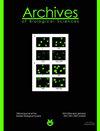Erianin是一种治疗多形性胶质母细胞瘤的有前景的药物,可触发U373和A172胶质母细胞瘤细胞的凋亡
IF 0.8
4区 生物学
Q4 BIOLOGY
引用次数: 3
摘要
胶质母细胞瘤是一种侵袭性的、常见的、致死性的原发性颅内脑肿瘤。黄曲石斛中的一种二苄基化合物缬草苷的抗肿瘤活性。提取物,以前没有在胶质母细胞瘤中被证实。我们研究了缬氨酸对人U373和A172胶质瘤细胞的抗癌活性及其机制。采用XTT试验、逆转录聚合酶链反应(RT-PCR)/膜联蛋白V创面愈合试验和Matrigel?分别是入侵室。U373和A172细胞48 h的有效剂量分别为16 μ M和64 μ M。Erianin还通过抑制b细胞淋巴瘤2 (Bcl-2)、caspase-8、caspase-9和肿瘤坏死因子受体1型相关死亡结构域蛋白(TRADD),以及激活caspase-3和BH3相互作用结构域死亡激动剂(BID)基因表达,显著诱导细胞凋亡。此外,缬草素显著增加了U373和A172细胞的凋亡细胞数量,显著降低了U373和A172细胞的侵袭和迁移。综上所述,我们的研究结果表明,羊角苷可能是一种新的治疗性抗癌药物成分,具有有效的细胞凋亡作用和治疗胶质母细胞瘤的潜力。本文章由计算机程序翻译,如有差异,请以英文原文为准。
Erianin, a promising agent in the treatment of glioblastoma multiforme triggers apoptosis in U373 and A172 glioblastoma cells
Glioblastoma is an aggressive, common and deadly primary intracranial brain tumor in adults. The antitumor activity of erianin, a dibenzyl compound found in Dendrobium chrysotoxum Lindl. extract, has not been previously demonstrated in glioblastoma. We investigated the anticancer activity and underlying mechanisms of erianin in human U373 and A172 glioma cells. The effects of erianin on cell viability, apoptosis, migration and invasion were estimated by the XTT test, the reverse transcription-polymerase chain reaction (RT-PCR)/annexin V wound healing assay, and Matrigel? invasion chamber, respectively. The effective amounts of erianin in U373 and A172 cells were 16 and 64 ?M at 48 h, respectively. Erianin also significantly induced apoptosis by inhibiting B-cell lymphoma 2 (Bcl-2), caspase-8, caspase-9 and tumor necrosis factor receptor type 1-associated DEATH domain protein (TRADD), and activation of caspase-3 and BH3 interacting domain death agonist (BID) gene expression. In addition, erianin significantly increased the number of apoptotic cells in U373 and A172 cells and significantly decreased invasion and migration in U373 and A172 cells. Taken together, our results suggest that erianin may be a new therapeutic anticancer drug component with a potent apoptotic effect and a potential for treating glioblastoma.
求助全文
通过发布文献求助,成功后即可免费获取论文全文。
去求助
来源期刊
CiteScore
1.40
自引率
0.00%
发文量
25
审稿时长
3-8 weeks
期刊介绍:
The Archives of Biological Sciences is a multidisciplinary journal that covers original research in a wide range of subjects in life science, including biology, ecology, human biology and biomedical research.
The Archives of Biological Sciences features articles in genetics, botany and zoology (including higher and lower terrestrial and aquatic plants and animals, prokaryote biology, algology, mycology, entomology, etc.); biological systematics; evolution; biochemistry, molecular and cell biology, including all aspects of normal cell functioning, from embryonic to differentiated tissues and in different pathological states; physiology, including chronobiology, thermal biology, cryobiology; radiobiology; neurobiology; immunology, including human immunology; human biology, including the biological basis of specific human pathologies and disease management.

 求助内容:
求助内容: 应助结果提醒方式:
应助结果提醒方式:


